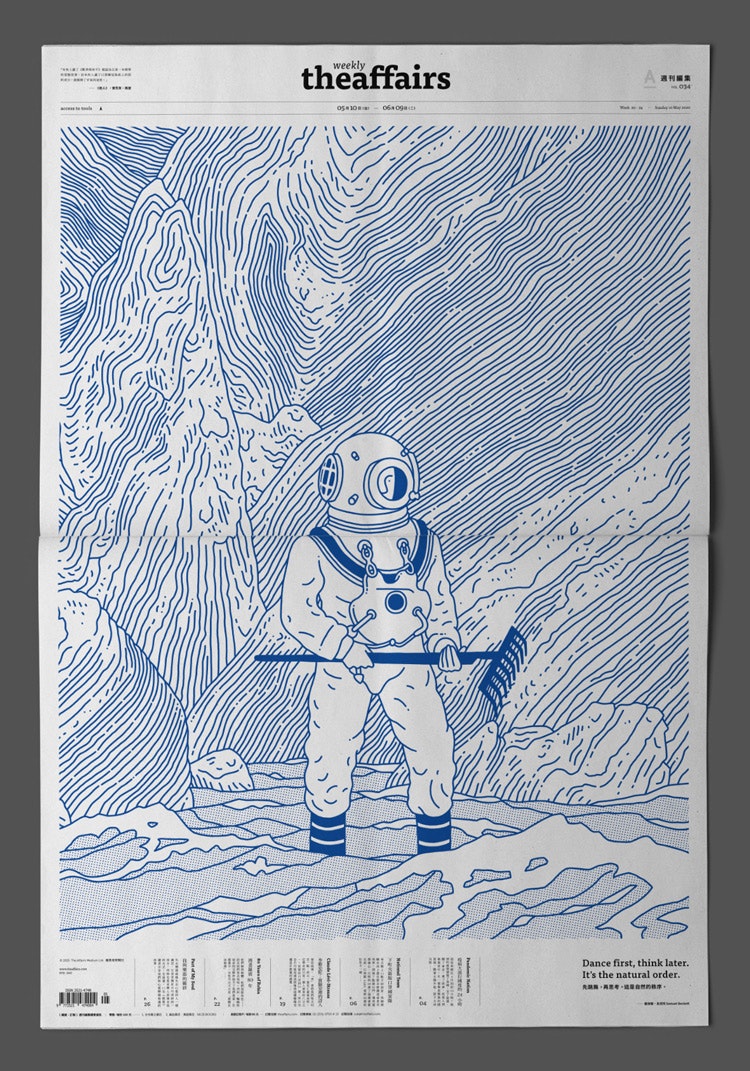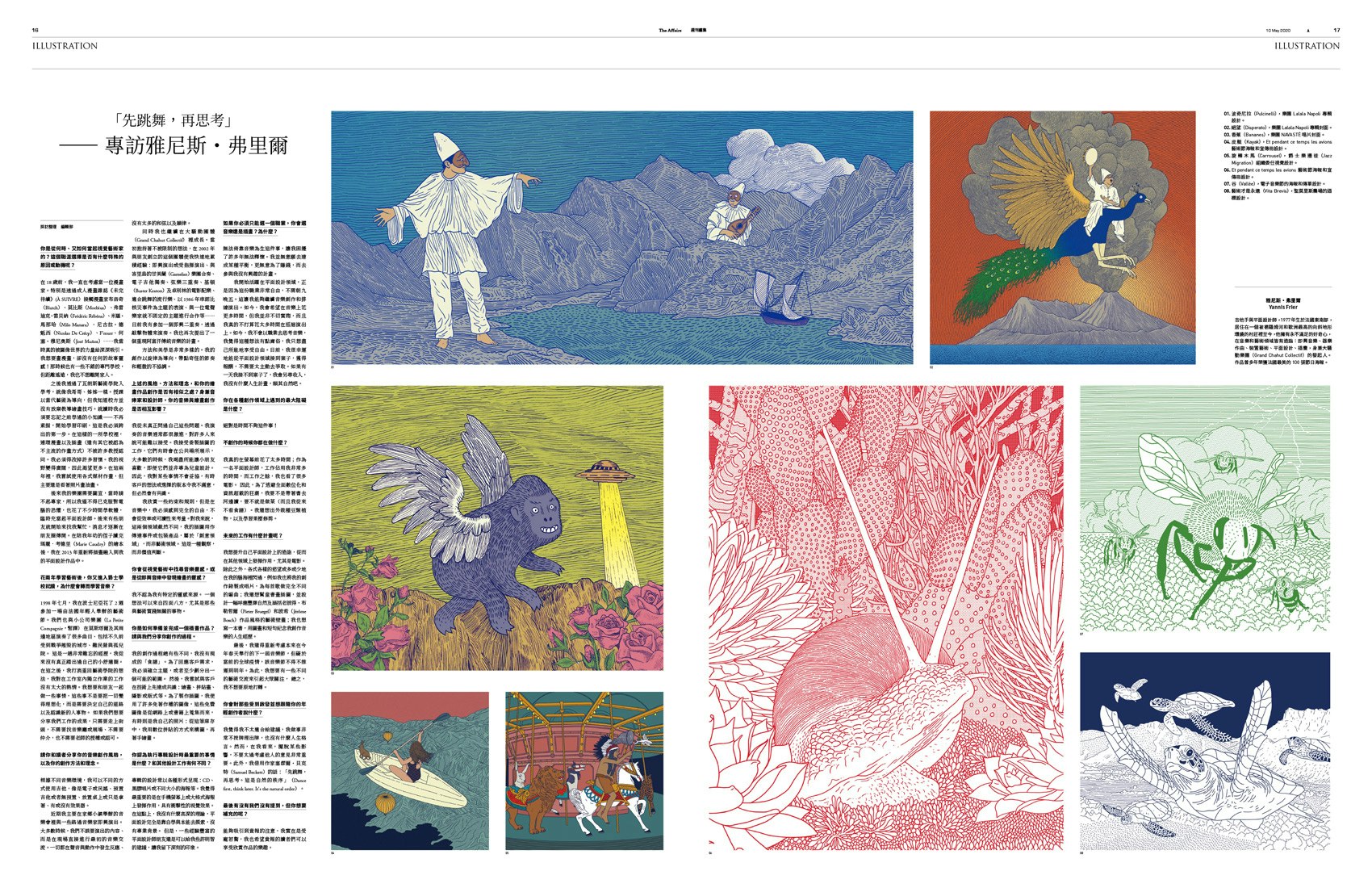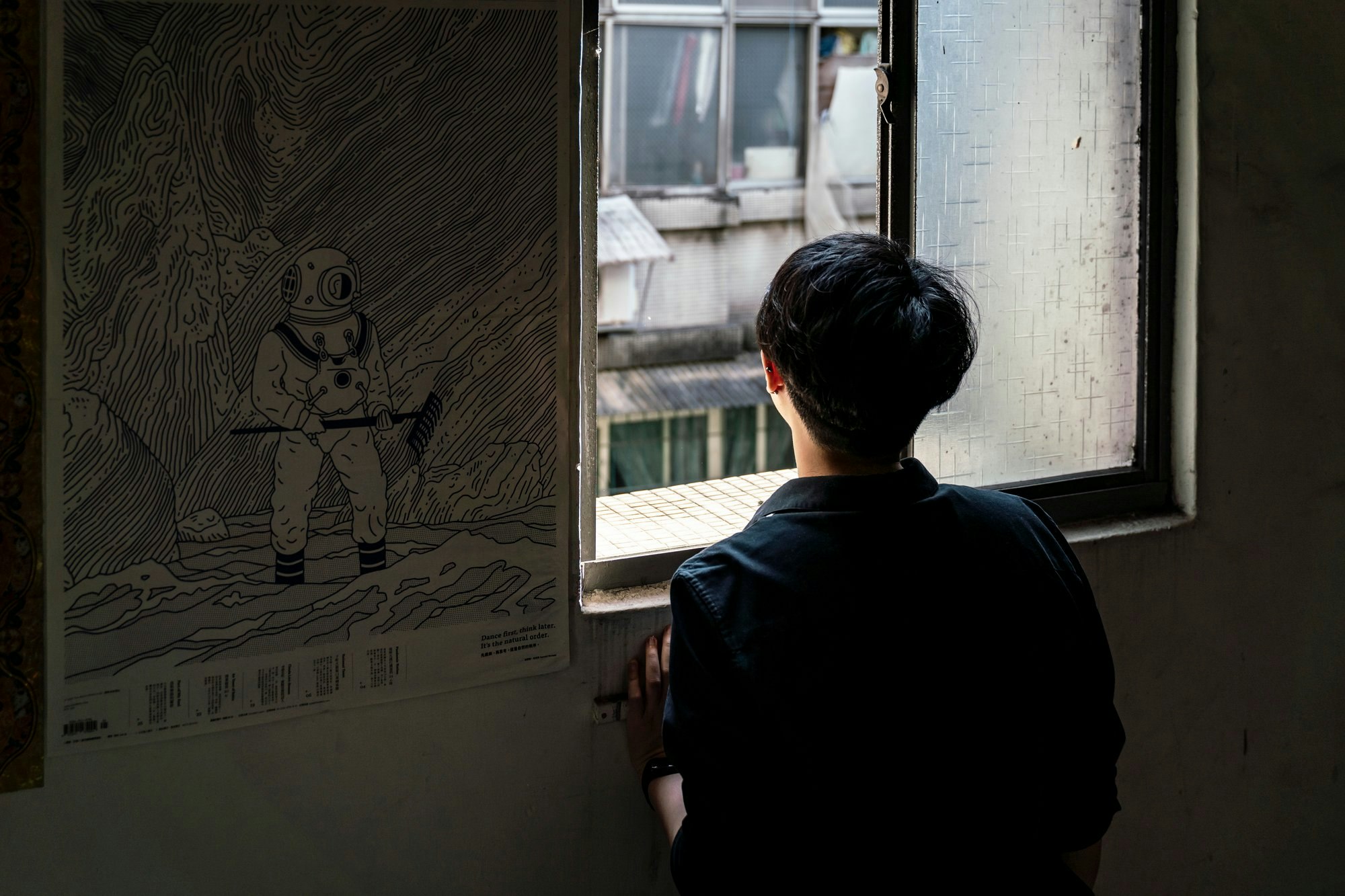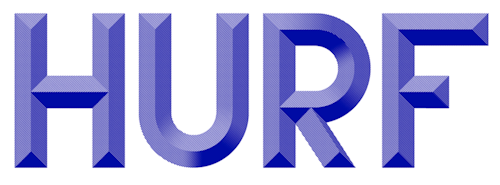entretien • interview
The Affairs 週刊編集 n° 34, Taïwan, April 28th 2020
CLIQUEZ ICI POUR LIRE LA VERSION FRANÇAISE

When and how did you start working as a visual artist? Was there a specific turning point or motivation for this career choice?
Up until the age of 18, I considered becoming a comic book designer. I had discovered adult authors and cartoonists very early on, thanks in particular to the french magazine (À SUIVRE). Blutch, Moebius, Frédéric Rébéna, Milo Manara, Nicolas De Crécy, F'murr, José Muñoz… I was really fascinated by the strength of these graphic universes. I wanted to do comics, but I had no story to tell. Institutions of higher education with specialised departments appealed to me, but they were far from home and I didn't want to move too far away from my friends and my family.
Following in the footsteps of my brother I took the entrance exam to the College of Fine Arts in Valence, a school my sister also attended after me. The teaching leaned towards contemporary art but also recognised the importance of the fundamental art of drawing.
There I must have forgotten all my little achievements: no more sketching to then move on to inking, the first stage had to be assured. In such a school comic books and illustrations (as well as many other practices) did not seem to be taken seriously and were even discouraged by the majority of the teachers. I was forced to change my habits. My desires evolved and new perspectives emerged. During these 2 years in Valence I worked with various mediums but I mainly practiced oil painting, from photographs.
When the bands I was playing in needed visuals I saw an opportunity and began to improvise as a graphic designer. We couldn't really afford to employ professionals so I came up with some concepts, overcame my reluctance to use computers and spent countless hours learning graphic design software. Soon friends came to me for my help and my services and then friends of friends and so on. In 2013 after reading a book to my very young nephew which was illustrated by Marie Caudry, I began reintegrating drawing into some of my graphic design work.
After spending 2 years studying art, you entered a jazz school. What made you decide to study music?
In
July 1998 I spent 2 weeks in Bosnia and Herzegovina at a music
festival organized by young French people. With my group La
Petite Compagnie we then performed a lot in and around Mostar, a
city recently devastated by the armed conflict and in a refugee camp
and an orphanage... It was a very memorable time. Up until this time
I had never really left my comfort zone and after this experience the
prospect of returning to Fine Arts and the loneliness of the studio
did not really excite me. I felt the need to do things collectively,
with friends, to assert something without having to intellectualize
everything, to hit the road and meet new people. With this musical
group, if we wanted to share the fruit of our labor, all we had to do
was go out into the streets, there was no need for a concert hall or
exhibition space and no need for intermediaries, approval or
authorisation.
There are hardly any musicians practicing the prepared guitar in Taiwan. Present your style of music to our Taiwanese readers, along with your creative methods and ideas.
I haven't really played prepared guitar over the last few years. Depending on the musical context, I have been able to use the guitar in very different ways: electric or acoustic, prepared or not, placed on a table or held in a more traditional way and with or without effects pedals. Lately I mostly enjoy improvising with visiting musicians, during concerts that I organize in my village. Often we don't even talk about what we're going to play and our first musical exchanges are in public. Everything is played out in the sound and the dynamics, harmony and rhythms are never obvious.
I am still working with the Grand Chahut Collectif. A collective we started with friends in 2002 with the intention of not imposing limits or restrictions on our creative output. This allowed my experiences to multiply: including free or guided improvisation, accompanying Balinese gamelan, solo electric guitar, an acoustic string trio, music for films by Buster Keaton and Charlie Chaplin, popular dance music, a performance based on the 1986 Chernobyl disaster, collaboration with an electroacoustician based on the theme of precariousness...
Currently I participate in an improvisation duo in which I mainly perform with objects and I have also relaunched a project to re-read certain traditional music from Afghanistan. The approaches are therefore very diverse and the aesthetics fragmented. My own compositions are more oriented towards melodies, playing with asymmetrical time and incorporating dissonance.
Do the style and creative methods and ideas of your music share any similarities with your illustrations? As a musician and also as a visual artist, do your music and illustrations influence each other?
I have never really asked myself these questions. The music that I practice is sometimes very radical and probably inaccessible to many people. My illustrations are usually commissioned work although sometimes they end up being displayed in public spaces and most of the time I do my best to make them appeal to children, even if they are not intended for them. There are sometimes restrictions and sometimes I am not completely satisfied with the idea or the version chosen by the client, so with my design work there is often some degree of compromise but at the same time I do enjoy working within some constraints and rules.
As for music, I need to feel totally free and uninhibited and prefer not to think in terms of efficiency or readability. For me, these are two quite different fields: my illustrations are used for communication of events or for packaging products and thus I feel they belong to the "creative" domain, but cannot really be considered art. This is just my opinion and not any kind of reflection of their inherent value.
Are you looking for musical inspiration in the visual arts, and vice versa?
An idea can come from anywhere, especially from things unrelated to artistic practices.
Share with us the process of creating a visual.
My creative process is always a little different, I don't follow any preset recipes. To respond to the clients request, I must initially identify the subject, or at least narrow down the field of possibilities. I then try to reach an agreement with the client as to the principle technique that will be used: drawing, collage, photography or typography… To make the illustrations I use a lot of royalty-free images, gleaned from the internet or in books, sometimes my own photographs: from this supply I then proceed to digital collages to create compositions that I then draw.
What do you think is most important for a record sleeve? How is this different from other graphic design work?
Album visuals can come in many different forms: CD covers, vinyl album sleeve design and posters of different sizes. It seems to me the most important thing is to produce visuals that have an impact and are effective both on a smartphone screen or as a large format poster. I don't have solid theories on this subject and I’m totally self-taught in the field of graphic design. I search instinctively, without specific guidelines. A few experienced graphic designer friends have nevertheless been able to give me some good advices that have been useful.
If you had to choose between music and the visual arts, which career would you choose and why?
For
many years, I had a hard time getting used to the idea that I could
barely make a living from music. I didn't want to compromise and play
in projects that didn't really interest me just for the sake of
making money. I began developing my graphic design activity because I
could exercise it quite freely, without fixed hours. This allowed me
to continue play music, rehearsals and concerts. Today I wish I had
more time to practice music, but I don’t miss the past and I don't
want to spend too much time on the road anymore.
I don't like to think in terms of a career, I just do my
best to feel free. I am fortunate to receive paid orders for my
design work with little advertising on my part but if one day I don't
get any more orders, I will look elsewhere, I have no plan.
What is the biggest obstacle to your creative pursuits?
Certainly the lack of time!
What do you usually do when you are not creating something?
I really spend too much time in front of screens; my work as a graphic designer occupies me a lot and on top of that I watch a lot of movies. So to escape the all-digital and the frenzy of too much information, I like go to down to the river with a book or I cook, still without a recipe. Now, I would like to go out to sow beans and learn how to prune fruit trees.
What do you plan to work on in the future?
In the field of graphic design, I want to develop my skills and work in other fields, in particular cinema. In addition, various desires have crossed my mind for a shorter or longer time, such as recording an album around my compositions with a different orchestration for each piece.
I would also like to illustrate children's stories and design an aesthetic fresco combining abundant nature with nods to the works of Pieter Brueghel and Hieronymus Bosch. I also have an idea for a book in which drawings and short sentences linked to my personal experiences would confront each other, without forgetting my desire to build musical machines.
I also have to rethink the next edition of a festival which was supposed to take place this spring but which has had to be postponed until next year due to the current pandemic situation. For this event I imagine provoking incongruous artistic encounters which would sometimes involve the public. I'm just trying not to go around in circles.
What advice would you give to young creatives inspired by your work who would like to do the same thing as you?
I feel very poorly placed to give advice, I am sorely lacking in methods and have no manifesto to write. However, it seems very important to me to be free from certain influences and not to take into account the opinions of others too much. Otherwise I gladly borrow these words attributed to Samuel Beckett: "Dance first, think later. It's the natural order”.
Finally, is there anything I forgot to mention that you would like to share with us?
I'm flattered to have garnered the attention of your newspaper and I hope some of your readers have enjoyed viewing my images!


